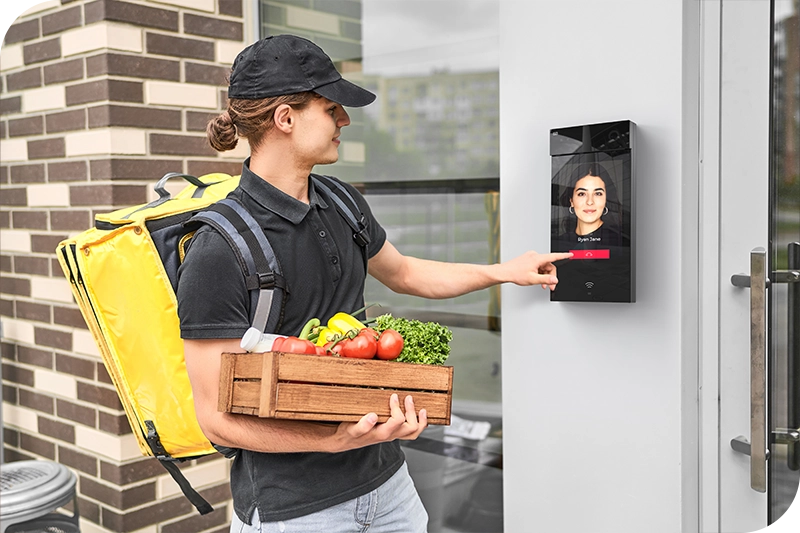The 5 must-have features of an IP Intercom
 Camilla Ashdown, 05. 05. 2023 | 4 min read
Camilla Ashdown, 05. 05. 2023 | 4 min read
IP intercoms today come with a range of advanced features – however sometimes it can be confusing to know which is best. Let us talk you through the essential five features needed for a future-proof IP intercom!
What is an IP intercom?
An intercom is a communication device installed at doors (usually front entrances) and other areas (car parks, garages, etc.) that restrict access to the area. The person trying to enter needs to either present valid authentication (an RFID card or a PIN code, for example) or call the relevant people within, who, after verifying the visitor’s identity, will grant them access.
An IP intercom is a communication device that allows for two-way audio (or video) communication over an internet protocol (IP) network. It’s worth mentioning that the best features available today are made possible thanks to IP technology; so, if you have an old analogue system, it’s advisable to convert it (which can be done easier than you think!)
IP intercoms typically consist of a microphone and speaker, as well as network connectivity for transmitting audio data over the network. Some models may also include things like a camera for video communication, or a keypad for entering access codes: however which features are the best?
1. A high-quality camera
Although some projects don’t require a camera, it’s a feature which shouldn’t be underestimated or overlooked. It heightens security considerably – audio alone can not always be the best way of verifying a visitor is who they say they are.
However, are all cameras created equal? Certainly not! A poor-quality camera will provide blurry or grainy images, making it difficult to identify visitors and leading to potential security issues.
A high-quality, full-HD camera, on the other hand, will provide clear images, allowing residents to identify visitors and potential intruders easily. Don’t neglect lighting, either – the camera should display clear images no matter what. In (quite common) instances where the light is shining from behind the visitor’s back, an IP intercom that supports WDR (wide dynamic range - a function which lightens the dark areas and darkens the overexposed parts of the image) will automatically compensates for the different levels of light in different areas of the image to ensure it’s totally clear.
A camera with a wide viewing angle is also useful, since it gives a large overview of the entire entrance as well as the visitor, useful in situations wherein the visitor is entering with multiple people who also need to be verified. It can be the case that wide viewing angles, because they cover such a large field of view, mean that people’s faces (and other details such as ID badges) are smaller. The solution? Something new to the intercom industry: adaptive face zooming, which allows the IP intercom’s camera to detect the face in the frame and zoom in, as well as reacting adaptively to the people in the frame.
Find out more about adaptive face zooming in IP intercoms: it’s only offered by us!
2. Multi-access
Any modern development should offer their users more than one way of accessing the building. If there is one thing that IP technology can provide those who use it, it’s flexibility and more convenience: and access control is not exempt from that.
Let’s take a residential development as an example – for instance, a smart-home, multi-use project (which are becoming more and more common). A huge amount of people is coming and going, and all of them don’t have the same permissions for the same areas, or indeed the same requirements from their access control.
The permanent residents might prefer mobile access – it’s convenient and fast. However, grandma visiting might not be able to get to grips with it and building managers cannot assign mobile credentials to absolutely everyone, so an IP intercom that only offers mobile access is not practical. Having something such as PIN codes as a backup is advisable. Another access method also great for assigning one-time credentials is increasingly popular QR code access.
In commercial settings RFID cards are still very popular and can be made more secure thanks to the latest encryption technology. However, they can prove wasteful (people often misplace them) in ways mobile access isn’t – which has led to a fast-growing trend of implementing mobile access technology in commercial developments. Of course, they still need a smooth transition, and some solution in multi-company developments with the same entrance yet different needs. So, offer both in one IP Intercom!
The best IP intercoms combine all four of these access methods in one device.
3.Remote capabilities: from features to management
IP technology is often based on a cloud platform, or cloud service, which allows the IP intercom to communicate to other devices via the internet. This opens up a quite unique benefit for residents: the ability to answer calls from their door no matter where they are in the world.
We already mentioned how great mobile access is, and mobile apps that function as indoor stations are just as great at offering more convenience. Video calling, and the simple ability to give instructions to a delivery driver when the resident isn’t at home are all great parts of apps such as this. Plus, when paired with an IP intercom that has a good camera – these apps can function as a form of home surveillance by allowing the user to use the app to stream the feed from the intercom at the front door remotely.
How to set up this cloud calling? By taking advantage of another benefit of IP intercoms: remote management platforms. Remote management and configuration of devices is becoming a crucial feature in modern intercom systems. Advanced features such as cloud calling and access rules can be configured from the comfort of the property manager’s office. What’s more, they will be able to deal with a vast majority of issues remotely. This saves property managers and admins time and travel costs.
4. Integration with other systems
Another genius feature of IP technology is that you can use it to create a cohesive solution across entire projects. Such solutions can include access readers, security systems, CCTV cameras, plus indoor stations (and/or mobile answering apps) for residents in residential projects and third-party office platforms for commercial ones. How can you connect the front door to this solution? By ensuring the modern IP intercom can integrate with other security systems, and easily too.
Look for providers that partner with third-party platforms and build their products on open protocols to make integration hassle-free and to ensure your users can enjoy a seamless experience when entering their buildings.
5. Being made to last
IP intercoms come with many advanced features, and some even rival the latest smartphones for their premium finish and sleek touchscreens. However, this doesn’t mean they should be fragile, or even that they should be thrown away after one year when the better version is released!
Try to choose a provider that prioritises development, durability, and testing. IP intercoms are often installed outside and is therefore exposed to various weather conditions. A good IP intercom should be durable and weather-resistant to ensure that it can withstand harsh conditions and continue to function properly. They should also be able to handle a lot of everyday use, particularly if they are installed in busy environments. The quality of materials used are also important; cheaper materials sourced from bad providers won’t last long, and although the initial cost of a premium IP intercom may be higher, it will last years and years without needing to be replaced and showing minimal signs of wear and tear.
The technology inside the IP intercom should also be future-proof and innovative: a provider that regularly reacts to market demands, changing requirements from customers, and always has an eye towards the future is very important. Also, to save installers the hassle of changing devices every few years to get the latest features, the best providers should produce scalable technology that can be updated in the same device. An OS with regular updates and new features, plus the integration capabilities mentioned previously, ensures that the technology you install can be scaled to whatever new demands projects or customers can throw at you.
So, there you have it! To read more on the best in future-proof IP intercoms, be sure to download our new eBook: Access Control 3.0.
